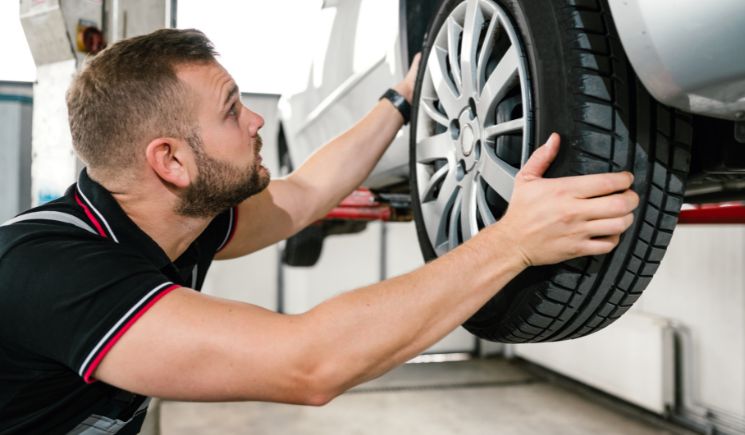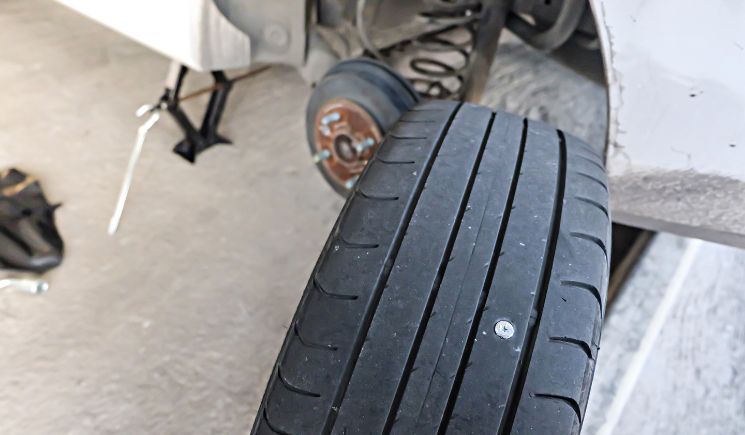Will Alignment Fix Uneven Tire Wear

Maintaining the health of your tires is essential for keeping you safe on the road and ensuring optimal fuel efficiency. Uneven tire wear can be a major problem for drivers, leading to costly repairs and decreased performance. Is there anything that can be done? Wheel alignment may just be the answer. Let’s take a look at how this process works and find out if it could help fix uneven tire wear.
Table of Contents
- How Wheel Alignment Works
- Can Wheel Alignment Fix Uneven Tire Wear?
- Frequently Asked Questions
- Conclusion
How Wheel Alignment Works
With proper care, you can ensure your wheels stay in check, preventing a bumpy ride down the road.
Wheel alignment is an important part of this process and involves adjusting angles of the tires so they are perpendicular to the ground and parallel to each other.
These angles are measured using specialized equipment such as toe plates, camber gauges and turn plates. Any misalignment can cause uneven tire wear, leading to poor handling and decreased fuel efficiency over time.
To get the best results from wheel alignment, it’s important to have a professional perform the service at regular intervals as DIY methods may not be accurate enough. Furthermore, cost for alignment services vary by location and service provider so it’s best to compare before making a decision. Subsequently, let’s look into whether wheel alignment can fix uneven tire wear or not.
Can Wheel Alignment Fix Uneven Tire Wear?

You may be wondering if wheel alignment can help with uneven tire wear – the answer is yes! Alignment can definitely help, but it might not completely resolve the issue. Uneven tire wear is usually caused by improper maintenance or lack of rotation. If tires are already worn down, an alignment won’t fix them.
However, alignment does have its benefits. It can improve vehicle handling and safety, increase fuel efficiency, and prolong the life of your tires. It’s important to get a professional alignment service done regularly in order to maintain even tire wear and reap these benefits. DIY alignments may not be as accurate, and cost will vary depending on your location and service provider.
Frequently Asked Questions
What are the signs of uneven tire wear?
As a car owner, you may notice signs of uneven tire wear if your tires are not maintained properly. Unevenly worn tires can give off warning signs such as bald spots, cracks in the treads, and a bumpy ride when driving.
Keeping an eye out for these indicators can save time and money by getting them fixed right away. Regular professional alignment services are recommended to keep your vehicle running smoothly and help prevent uneven tire wear.
How often should I get an alignment service?
Getting an alignment service regularly is important for maintaining the health of your tires and vehicle in general.
Generally, it is recommended to get a professional alignment service every 6 months or every 10,000 miles (whichever comes first). This will help you maintain proper tire wear, improve your vehicle’s handling and safety, increase fuel efficiency, and prolong the lifespan of your tires.
DIY alignment may not be as accurate as a professional service so it is best to seek out a qualified technician who can provide quality results at a reasonable cost.
What are the potential dangers of driving on unevenly worn tires?
Driving on unevenly worn tires can be dangerous, as it can cause a vehicle to handle poorly and decrease fuel efficiency. Uneven tire wear is typically caused by improper tire maintenance or lack of rotation and ultimately leads to decreased traction, increased stopping distance, and a bumpier ride.
As such, it is important to regularly check your tires for signs of abnormal wear and tear and promptly seek professional alignment service if necessary in order to ensure optimal safety.
Are there any other ways to fix uneven tire wear?
I’m often asked if there are any other ways to fix uneven tire wear. While alignment can help prevent and correct some of the issues caused by an unevenly worn tire, there are also steps you can take to prevent it from happening in the first place.
On average, a set of tires will last anywhere between 25,000 and 50,000 miles – but regular maintenance is key for maximizing their lifespan. That means keeping your tires properly inflated, rotating them periodically (every 5,000-7,500 miles), and getting a professional alignment service done regularly.
These measures will not only help reduce the amount of wear on your tires but also improve vehicle handling and fuel efficiency.
Conclusion
Alignment can be a great help to preventing uneven tire wear, but it’s important to note that it won’t necessarily fix already worn tires. On average, alignment can improve fuel efficiency by up to 7%, so if you haven’t had your tires aligned recently, it could be well worth the investment. Keeping your wheels in alignment is an easy way to save money and ensure your car runs as efficiently as possible.






